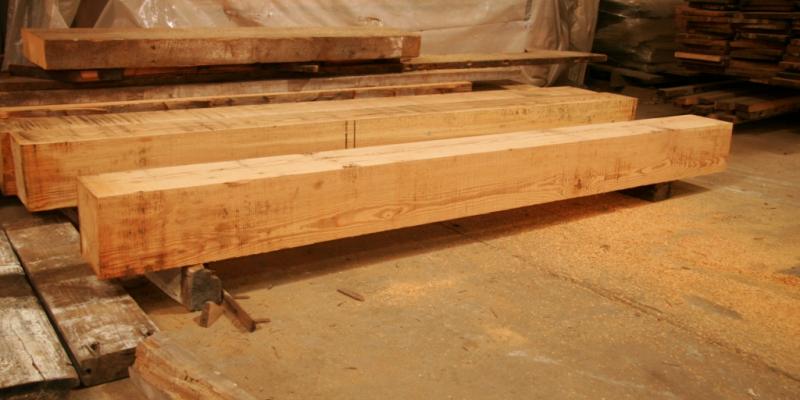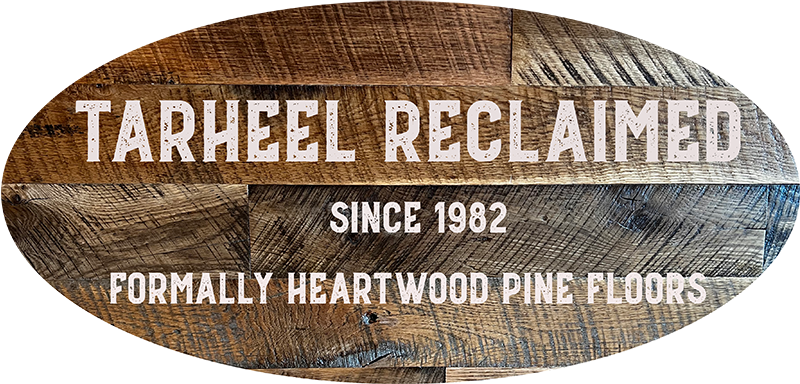Heartwood Pine Floors & Beyond, Inc. is proud to be a part of the new American consciousness to re-use and recycle. When buildings like the turn of the century Cannon Textile Mills in Kannapolis, NC were dismantled, they yielded tons of metal, brick and thousands of feet of antique heartpine. The wrecking ball and explosives have been replaced by the crane and crowbar to extract these precious resources. It gives us great pride to see a tractor trailer load of antique longleaf pine beams arriving at our mill, and we are always excited to see the beautiful grain and color re-emerge as new green recycled flooring for homes across America.
Our Lumber Reclaiming Process

Finding Reclaimed Wood
Floors and structural timbers found in mills, train stations, and most industrial buildings dating from the 1700s and 1800s are good places to search for reclaimed wood. In his search for reclaimed wood over these last thirty years, owner Larry Green has developed a keen sense for the color and grain that is truly antique wood timbers.
Antique Timber Reclamation
We work closely with professional LEED certified demolition companies and structural engineers to carefully extract these reclaimed mill wood timbers that can measure two feet wide and over 40 feet in length.
Manufacturing
The antique timber reclaiming process for floors actually started hundreds of years ago. Beams cut from antique wood were the architectural back bone of mills erected in the south during the 1700s and 1800s. It was there that the reclaimed wood began to slowly dry until it was extracted during demolition and sent to our facility to be rendered into antique flooring.
Each beam that arrives at our plant for reclaiming is inspected for end grain and color to make sure it is in fact antique longleaf pine. Tight growth rings and reddish color are the characteristic of old growth longleaf. Once we have determined that the beam is up to our standards, it is moved by fork lift to the denailing station where it is scanned for metal. The only method to extract metal from these timbers is through the careful use of specially-designed drill and nail pullers. Though this first step is tedious, it pays to be diligent in order to maximize the usable parts of the board and protect our machines further down the line. Sometimes we find amusing artifacts such as musket balls and old hand drill bits. All of the nails and other metals that are removed are recycled.
Beams that are cleared by the final sweep of the metal detector are moved to the saw. It is here where the wood is sliced into one inch planks that we get our first look at the true color and grain. It is always exciting to see an old grey beam with paint chips and rough exterior reveal its inner beauty with rich red tones and a variety of grain patterns.
Our lumber reclaiming process at our Chatham County, North Carolina facility has been designed to move a reclaimed beam through an efficient five-step process while recycling old metal and sawdust along the way.
Rendering large beams into recycled antique flooring requires a combination of specialized tools and skilled manual labor. Over the past 30 years, Larry has developed a five-step process that maximizes the yield of each board. The metal that is removed is recycled, and sawdust is collected and re-used to make organic soil.
- Denailing: Before any antique heartpine can be sent to the saw, all metal must be removed. This is a simple yet arduous task that requires a metal detector and a variety of hand tools.
- Sawing: It takes a mighty saw to slice a two foot thick beam of reclaimed factory wood. Our band saw has a blade over twenty feet in circumference, which allows to us reduce waste and speed production of our lumber reclaiming process.
- Kiln Drying: Timber reclaiming provides wood, which has been slowly air-drying for over one hundred years. We kiln dry our salvaged wood to insure consistent low-moisture content and to make sure the pine resin is set and crystallized at a high temperature.
- Grading: Each board is examined for grain density, color, knots, nail holes and is graded accordingly. Only years of experience and vigilant inspection at each step will determine the grade of antique flooring we offer our customers.
- Milling: One great advantage with our factory direct sales policy is the fact that we can mill just about any piece of reclaimed wood that your project specifies. In addition to making reclaimed mill wood into high-quality antique flooring, we can mill stairs, molding, mantles, banisters, paneling and more.
For more information on wood reclaiming and this antique wood, call us at our Chatham County, North Carolina headquarters at 919-542-4394 or fill out a form to receive a free Heartwood pine sample kit.

